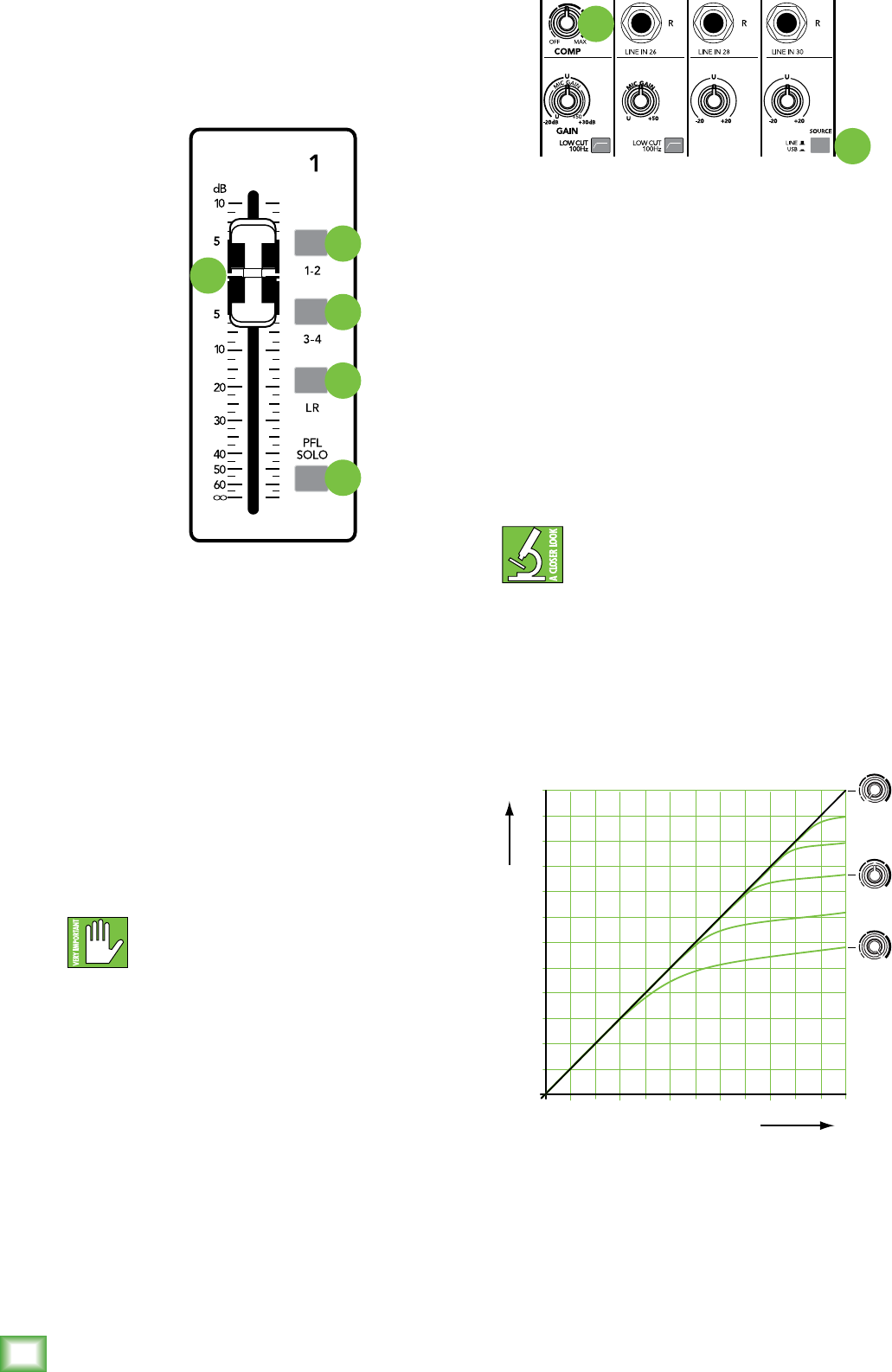
ProFX8v2 • ProFX12v2 • ProFX16v2 • ProFX22v2 • ProFX30v2
14
ProFX8v2 • ProFX12v2 • ProFX16v2 • ProFX22v2 • ProFX30v2
If you are creating new tracks or bouncing existing
ones, you will also use the 1-2 and 3-4 switches, but not
the main mix switch. Here you do not want the groups
sent back into the main mix bus, but sent out, via the
sub out jacks, to your multitrack inputs.
24. PFL Solo Switch
[ProFX16v2, ProFX22v2, ProFX30v2]
When a channel's solo switch is engaged, any existing
selection is replaced by the solo signal, appearing at the
control room outputs, phones and at the left meter. The
audible solo levels are then controlled by the CR/phones
knob. The solo levels appearing on the meters are not
controlled by the CR/phones knob – you would not want
that, anyway. What you do want to see is the actual
channel level on the meters regardless of how loud the
control room and phones output levels might be.
PFL means Pre-Fader Listen (post-EQ). With the PFL
Solo switch engaged, solo will not be affected by a
channel's mute switch position.
Remember, PFL taps the channel signal before
the fader. If you have a channel's fader set
way below “U” (unity gain), solo will not know
that and will send a unity gain signal to the CR outs,
phones output and meter display, which may raise some
eyebrows.
25. Channel Fader
This is the last control in a channel’s signal path, and
it adjusts the level of each channel onto the main mix.
The “U” mark indicates unity gain, meaning no increase
or decrease of signal level. All the way up provides an
additional 10 dB, should you need to boost a section of a
song. If you find that the overall level is too quiet or too
loud with the level near unity, check that the gain
control is set correctly.
23
25
23
24
23
27
26
26. Compressor
[ProFX16v2, ProFX22v2, ProFX30v2]
Each of the last four mono channels of the ProFXv2
mixer has an in-line compressor circuit with a variable
threshold. This is very useful for compression of vocals,
and snare drums, for example, so you might consider
connecting your vocal and drum mics to these channels,
rather than one of the other channels.
When the incoming signal exceeds the threshold level
set by this knob, the signal level is automatically
compressed. This reduces the dynamic range and
reduces the chance of distortion due to overloading the
input signals.
Dynamic range is the difference in level
between the quietest and loudest parts of a
song. A compressor “squeezes” the dynamic
range, resulting in an overall steadier, more constant
volume level for the signal. It helps sources, such as
vocals, “sit” properly in the mix; it is very useful for live
sound.
The compression ratio is fixed at around 6:1, with a
soft knee response. The threshold can be adjusted
clockwise from off (no compression) to 0 dBu (max).
As an example, suppose the threshold is set to
maximum. An incoming signal reaches the threshold of
0 dBu. As it increases beyond the threshold, it becomes
compressed at a ratio of 6:1. This means that even if the
input further increases by 6 dB, the actual output only
increases by 1 dB. This compresses the output signal, so
+20
-10
-5
+0
+5
+10
+15
+20-10 -5 +0
SLOPE 6:1
SOFT KNEE
SLOPE 1:1
+5 +10 +15
INPUT SIGNAL STRENGTH dBu
OUTPUT SIGNAL STRENGTH dBu
OFF MAX
COMP
OFF MAX
COMP
OFF MAX
COMP


















